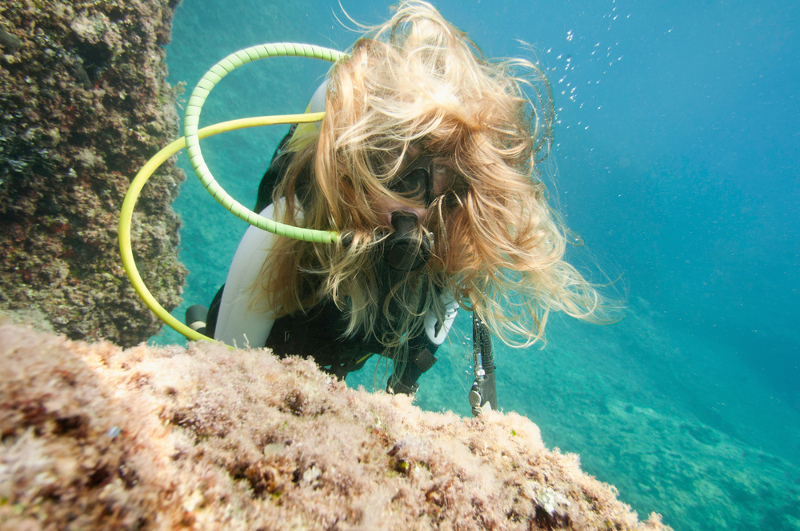Managing hair while diving can be a challenge that affects both safety and enjoyment underwater. Loose strands can obstruct your view or interfere with mask seals, turning a pleasant dive into a frustrating experience. This issue is common for divers of all experience levels, especially those with longer hair. However, there are practical techniques and preparations that can help keep your hair in check, allowing you to focus on exploring the underwater world.
Key Takeaways
- Rinse hair with fresh water and apply leave-in conditioner before diving to reduce tangling and shield against salt water.
- Style hair into tight French or double Dutch braids to keep it secure and close to your head during the dive.
- Wear a quality silicone or latex swim cap over your styled hair for added security and to prevent loose strands.
- Position the mask strap high on the back of your head above the gathered hair, using a figure-eight pattern for a better grip.
- Create a low bun below the mask strap and cover it with a securing net for extra protection against floating strands.
Pre-Dive Hair Preparation Methods
Preparing your hair before a dive is important for clear visibility and comfort underwater. Start by soaking your hair with fresh water to reduce tangling and make it easier to manage. Use a leave-in conditioner made for swimming to help protect against salt water damage.
For longer hair, divide it into sections before styling. Create tight braids or secure it in a low bun at the back of your neck to keep all loose strands in place. Opt for silicone hair ties instead of metal clips or rubber bands, as they won’t snag underwater. For shorter hair, a neoprene headband can help keep bangs and layers away from your face.
Apply a water-resistant hair gel or styling product to tame any flyaways and baby hairs, paying special attention to the hairline and temples where your mask will sit. This preparation helps keep your hair in check and can prevent mask flooding caused by stray hairs.

Best Hairstyles for Diving
Choosing the right hairstyle can enhance your underwater experience. It’s important to pick a style that stays secure and keeps hair out of your mask and equipment.
- French Braid: This style keeps hair close to the head, minimizing loose strands and staying intact during longer dives. Start the braid high on the crown and weave it tightly down to the nape.
- Double Dutch Braids: Two parallel braids offer excellent control for longer hair, evenly distributing weight and reducing pressure under the mask strap.
- Low Bun with Securing Net: A tight bun at the base of the neck, below the mask strap, can be covered with a fine mesh net for added security.
- Crown Braid: This wrapped style keeps hair flat against the head, making it suitable for shorter to medium-length hair that could float into your face.
These styles work well with dive masks and hoods, ensuring clear visibility while you explore underwater.
Essential Hair Management Tools
Effective hair management tools are essential for a comfortable underwater experience. To keep your hair in check while diving, it’s important to have a selection of specialized tools tailored for aquatic environments.
A quality silicone or latex swim cap acts as your main line of defense, providing a snug fit that keeps hair secure and protected. Neoprene bands and diving hoods offer extra support, especially in cooler waters where warmth is necessary. Sturdy elastic hair ties made from water-resistant materials ensure a strong hold without tangling.
Wide-tooth combs made for wet hair help minimize damage when preparing before your dive, while leave-in conditioner provides a protective layer against salt water. Diving masks with added skirt material help keep hair from disrupting the mask seal. Mask straps with neoprene covers prevent tangles, and split-strap designs distribute pressure evenly, reducing the risk of hair getting caught during your dive.
Mask Strap Techniques
Managing your mask strap effectively is key to keeping hair in place and ensuring a proper seal during your dive. The right handling of your mask strap helps prevent hair tangles while maintaining clear visibility underwater.
- Lift your mask strap high on the back of your head, positioning it above any gathered hair or ponytail for a secure fit.
- Cross the strap in a figure-eight pattern if you’re using a swim cap or hood; this helps distribute pressure and reduces slipping.
- Place the strap under any hair ties first and then over them for extra security that keeps everything in place.
- Adjust the strap’s tension gradually, starting loose and tightening until you find a comfortable fit that seals well.
For longer hair, try a neoprene mask strap cover, which adds grip and prevents hair from getting caught in the silicone strap. This approach, along with proper strap positioning, ensures your mask stays secure without interfering with your hair or diving experience.
Dealing With Different Hair Types
Different hair types require specific strategies to stay controlled underwater during diving. Fine hair tends to float easily and may benefit from combining a swim cap with braids for better hold. Thick, coarse hair generally stays in place but needs stronger bands and thorough securing techniques to manage its volume.
For curly hair, using leave-in conditioner before diving helps reduce tangles and simplifies post-dive care. A neoprene hood with extra space accommodates natural volume. Straight hair works well with sleek braiding methods, like French or Dutch braids that follow the head’s shape. Short hair can be managed with water-resistant gel or a thin neoprene beanie under the mask strap.
Long-haired divers should consider double-braiding, securing each section tightly at the base, middle, and ends. Those with layered cuts might need small clips or


